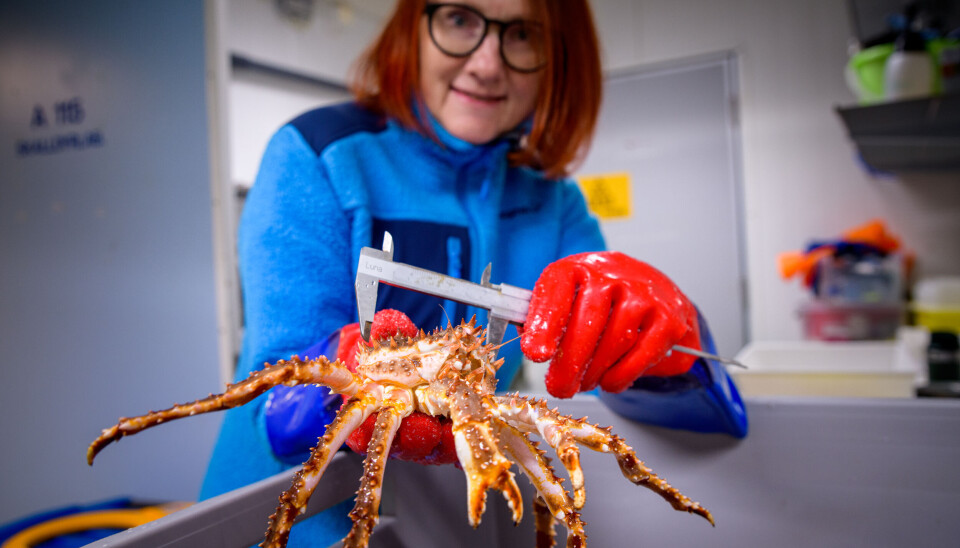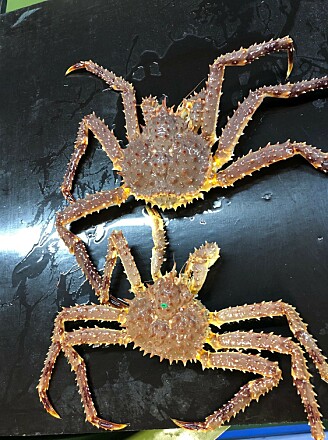THIS ARTICLE/PRESS RELEASE IS PAID FOR AND PRESENTED BY Nofima The Norwegian Institute of Food, Fisheries and Aquaculture Research - read more

Former intruder may become luxury product: The red king crab is a great candidate for farming
The goal is to turn a problem into not just an asset, but a luxury product.
Nofima's crab researchers are keen on feeding small red king crabs until they reach commercial size.
Key words for success are the right food, the right environment, and the right conditions. All pieces currently seem to be falling into place.
“The crab has turned out to be a good candidate for rearing, and has now become a farm animal, which we have gradually learned how to manage. We know much more about what it takes for crabs to thrive in captivity: To eat, grow, and be nice to each other. And we are now in the process of determining the right feed as well,” Sten Siikavuopio says. He is a long-time crab researcher at Nofima.
“If we succeed, we will potentially have laid the foundation for a completely new industry in western Finnmark,” Grete Lorentzen says.
She is also an experienced crab researcher and head of the Helt Konge (crab is king) research project.
The red king crab migrates south and west
The story is as follows: In the 1960s, red king crab – Paralithodes camtschaticus – was released into the Murmansk Fjord, just east of the coast of Finnmark.
About 15 years later, the crab was discovered in the Varangerfjord.
Since then, this long-legged crustacean has spread along the coast of Finnmark and Troms county.
The red king crab is still migrating west and south, eating everything in its path across the seabed. However, from being an intruder and causing irritation and despair for the established fisheries, the red king crab is now considered a lucrative delicacy.
The 26th east meridian starts approximately at Honningsvåg. East of it, the red king crab fisheries are highly profitable, and regulated by quotas.
Consumers do not want small crabs
However, west of the North Cape, the red king crab is considered an invasive species – that is, it spreads to areas outside its natural habitat and impacts all other living organisms there.
Norwegian fisheries authorities intend to reduce its presence west of the quota-regulated area and have therefore established a free fishing zone west of Honningsvåg.
In the free fishing zone, the crabs can be captured and brought onshore regardless of size.
The problem is that this is not an attractive fishery for professional fishermen. The crabs caught west of Honningsvåg are generally too small for buyers in the international market, who want Norwegian king crabs weighing at least 1 to 2 kilograms.
Vulnerable during molting
A year ago, researchers started feeding small crabs, weighing about 250 grams, obtained from the free fishing area. This is a part of the research study, and the aim is to reach a weight of 1.6 kilograms or more three years into the project.
“Before we get that far, the crabs have to undergo multiple cycles of moulting. That’s how they grow. The moulting stage is a critical phase for the crab, as that’s the time when they are the most vulnerable,” Sten Siikavuopio says.
The crabs in the Nofima project have to go through 3-4 such critical moults to reach commercial sizes. After achieving an initial successful moult, the researchers are optimistic.
“So far, the results have exceeded all expectations. The moulting indicates the crab grows well, and the mortality rate associated with the moulting was less than ten per cent, which are excellent numbers," Siikavuopio says.
The extent of the increases in size and weight per moult is an indication of how well the crab is doing.

Knowledge will be in high demand
The Nofima scientists believe that knowledge on how live storage and feeding of small king crabs should be done, will be in high demand both in Norway and abroad.
“Nofima's
strength lies in its interdisciplinarity. We have biologists who understand
what it takes to make the animals thrive, and our colleagues at the research
station in Bergen produce the feed we use based on our knowledge of what works
best for crabs. In addition, we have expertise in product quality and consumer
perceptions, which allows us to have an approach where we consider the entire
value chain in our work," Siikavuopio says.
As with all animal farming, time and feed costs are critical factors in terms of profitability. By starting with wild-caught small crabs, it is possible to save both time and feed costs.
“And if we start with slightly larger crabs than we used in the study, less feed will be required before the crab reaches a size that’s attractive to the market, thereby avoiding large feed expenses,” Grete Lorentzen says.
Crabs eat like a four-year-old
The great thing about the red king crab is that it will eat practically anything, making it a great candidate for farming.
Running parallel with the Helt Konge project is the research project Kongemat (Food for kings). There, researchers are busy investigating how residual biomass from other marine species can be used as a feed source for farmed crabs.
Shrimp shells and lumpfish are key words here.
It is important to find the feed that generates the least waste and maximum growth.
“You see, the crab eats like a four-year-old. Half the meal ends up on the floor. We are therefore working to develop a feed with a structure that minimises spillage,” explains Sten Siikavuopio.
The traditional approach in aquaculture has been to feed animals on a daily basis. The researchers believe we might benefit from reconsidering this approach. A theory which can be worthwhile to try out is that the crab might better utilise the feed if it is served less frequently.
“For example, three times a week instead of every day. In theory, that would make it ingest everything it spills to the floor during the first serving,” the crab researcher says.

This article/press release is paid for and presented by Nofima The Norwegian Institute of Food, Fisheries and Aquaculture Research
This content is created by Nofima's communication staff, who use this platform to communicate science and share results from research with the public. Nofima is one of more than 80 owners of ScienceNorway.no. Read more here.
See more content from Nofima:
-
Red algae grown in wastewater from fish-farming facilities could become sustainable salmon feed
-
Pumpkins are good for more than just Halloween decorations
-
This is how temperature affects a salmon's health and growth
-
Study: Omega-3 and zinc is a powerful duo for salmon
-
Fish may turn yellow if frozen too fresh
-
Is it better if food is packaged in plastic or paperboard?




































